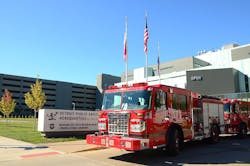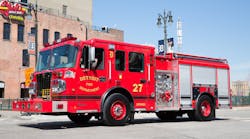SCOTTSDALE, Ariz. – Detroit Fire Department has been, and continues to go through challenging times as the Motown city recovers from bankruptcy and an unprecedented de-population of what was once the fourth largest city in the nation.
Until November, Craig Dougherty, a 38-year veteran of the department, served as the second deputy fire commissioner in charge of operations and apparatus. In October, a new fire commissioner was appointed with different ideas and Dougherty decided it was time to make his exit.
Dougherty, who started with the department in 1977, served in every rank in the department during his career. He shared his experiences keeping a broken down fleet of fire apparatus ready to protect the blighted city at the Fire Department Safety Officers Association’s 28th annual apparatus symposium.
“It was a very unique time for us,” Dougherty said to firefighters and officers.
He explained that Detroit has the land mass of San Francisco, Boston and Manhattan combined and once had a population of 1.5 million people. It has since fallen to about 700,000 leaving thousands of empty homes and blight on the community that drains resources, he said.
When he was first in charge of apparatus, he had 37 engines to protect the city and 11 of them were out of service requiring significant repair or replacement.
He also had 24 aerials with only 10 in service and most of those were not certified or tested and only 38 ambulances to cover the whole city. Dougherty said the city contracted with many private ambulances to handle the EMS runs and the city dispatched them as they would municipally-operated units.
With that rag-tag fleet, DFD answered 224,000 calls in 2013, with 7,000 plus coming in as working structure fires and 120,000 med calls. “You can only do so much,” he said.
Using maps and visual aids, Dougherty pointed out the extent of blight the city faces with more than 80,000 vacant homes in need of demolition at the cost of $14,000 to remove each one.
“We’re talking about hundreds of millions of dollars,” he said, adding that mayor’s office wanted to take down 200 per week.
Recognizing the challenges Detroit was facing, Roger Penske, owner of the famed Penske Corporation and racing team, donated $8 million to the city to purchase 23 ambulances and 100 police cruisers.
“I would have loved to gotten a fire truck or two out of that deal, but they said we needed ambulances more,” Dougherty said.
By December 2012, employees were experiencing “payless paydays” and the situation was dire, he said, noting that the city was $18 billion in debt and filed for Chapter 9 bankruptcy.
As reorganization under bankruptcy protection took place, all the city’s assets, including a treasured art museum, were eyed as potential collateral to pay down the debt. To prevent those kinds of things from happening private foundations and business stepped up and collected $866 million to help bail out the city.
At the same time, public employee pensions were reduced and pay for those employees was cut by 4.5 percent, he said.
Under the terms of a “plan of adjustment” the fire department was allocated $24.5 million for new apparatus, he said, noting he and the officers decided to purchase 15 new ambulances and 10 engines for a total cost of $4.7 million. The department also purchased 10 new rapid response vehicles and 21 department SUVs.
“Like an expectant parent, those fire trucks couldn’t get here fast enough,” Dougherty said.
And while the new apparatus was long overdue, there were some rank and file members of the department who issued a formal written complaint that the seat belt alarms were, “excessive and loud” and the department needed to do something about it, he said.
“They said they couldn’t hear the radios over the alarms, which means they weren’t using the seatbelts as required,” Dougherty said.
And, although Dougherty had come up through the ranks, he was immediately branded as a pejorative “one of them” when he became a commissioner.
But his changes for the department operations weren’t done then. He required all 800 firefighters to become certified for medical response, either as a responder or an EMT. And, he paid them overtime to get the training.
He also ran into problems with the rank and file when he replaced straight squads with rescue engines with 500-gallons of water, pumps and pike poles so they could have some fire suppression capabilities.
“You would have thought pigs started flying when I introduced that,” Dougherty said.
Firefighters would bend the mayor’s ears about all the changes Dougherty he was implementing and complain, causing the mayor to question Dougherty’s decisions and authority.
“You expend a lot of political capital making those kinds of changes,” Dougherty said, noting that last October, a new fire commissioner was appointed and by November, Dougherty decided to retire after 38 years.
Dougherty said many parts of the city are being revitalized, especially the downtown section where it has become a very desirable place to live with waiting lists of prospective tenants.
He is also proud to have helped guide the fire department to becoming more efficient and effective during his tenure.
“Change is always difficult for any organization, but it’s sometimes necessary,” he said.
More from FDSOA:
- FDSOA's Apparatus Symposium Opens in Ariz.
- FDSOA Symposium: Diesel Emissions Standards Need not be so Scary
- FDSOA Symposium: NFPA 2015 Apparatus Standards Reviewed
- FDSOA Symposium: Politics Play a Role in Apparatus Purchasing
- FDSOA Symposium: Experts Field Apparatus Questions
- FDSOA Symposium: Detroit FD Weathers City's Bankruptcy
- FDSOA Symposium: Apparatus Design Is Important for ISO Ratings
- FDSOA Symposium: Drones Can Be Valuable Tools For Responders
- FDSOA Symposium: NFPA Focused on Alternative Fuel Emergency Safety
- FDSOA Symposium: Graham Lectures on True Risk Managment
- FDSOA Symposium: Pros and Cons of Thermal Imagers Discussed
- FDSOA Symposium: Maintenance is Key to Keeping Apparatus on the Road










